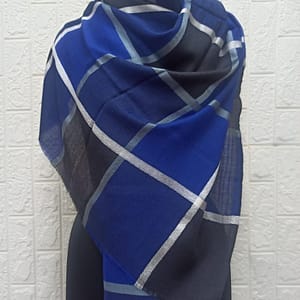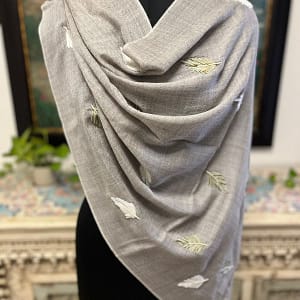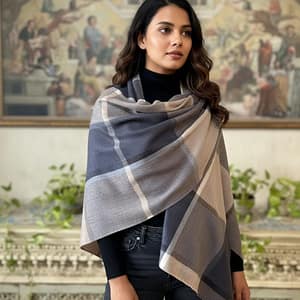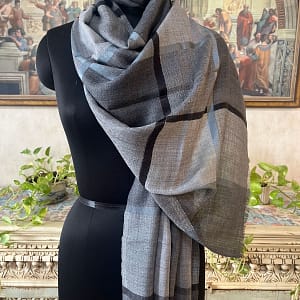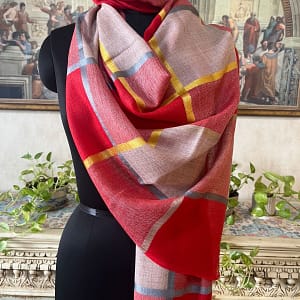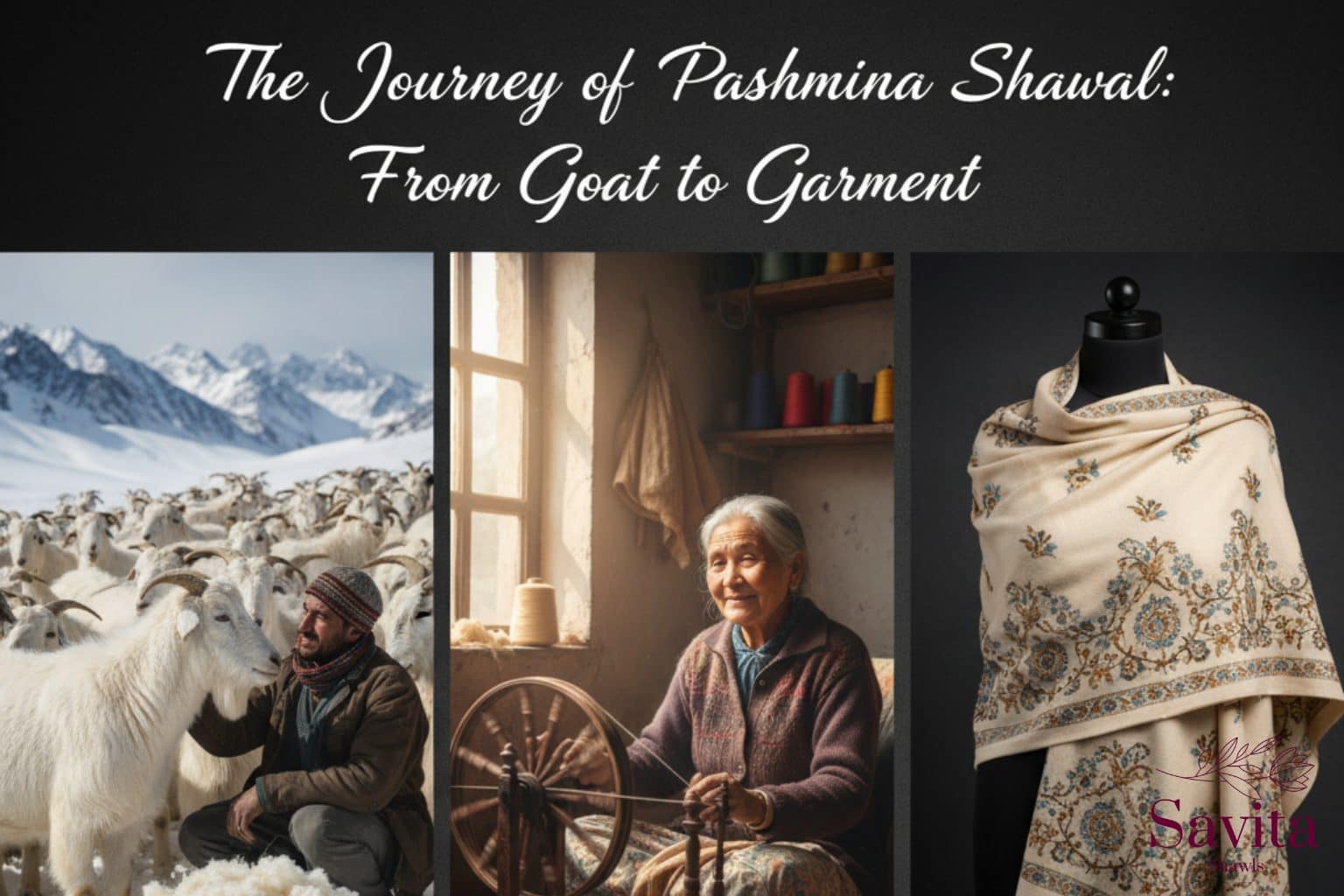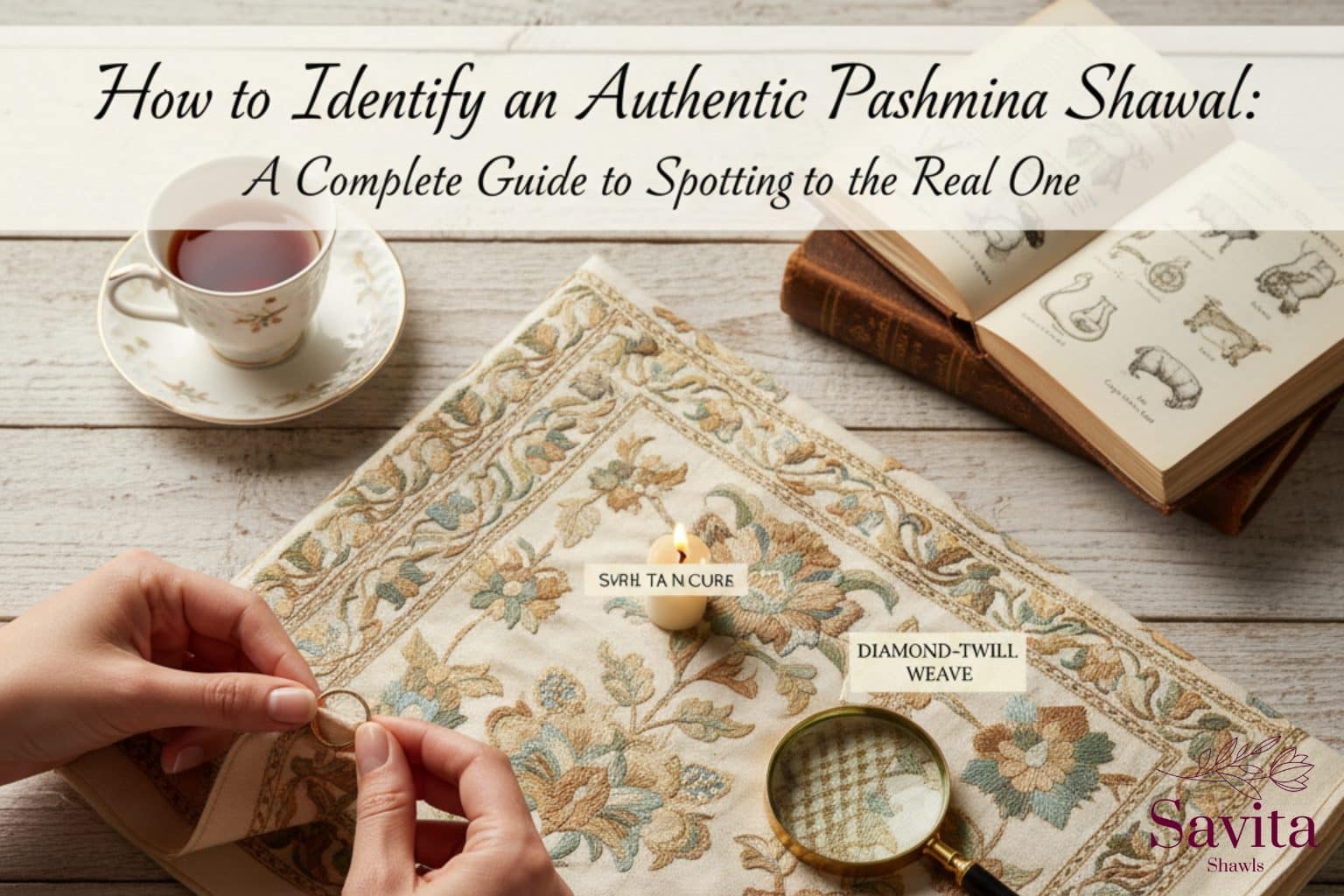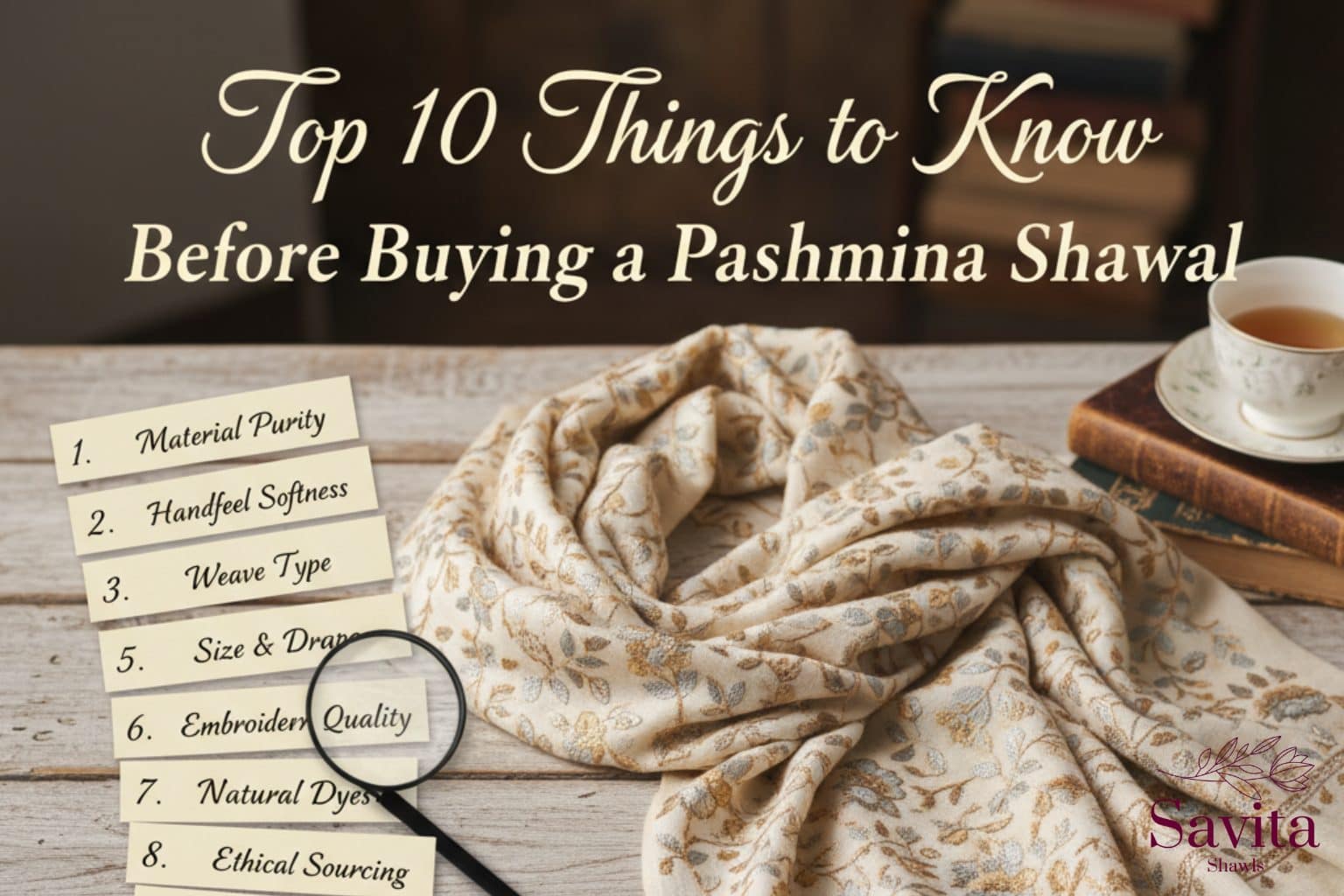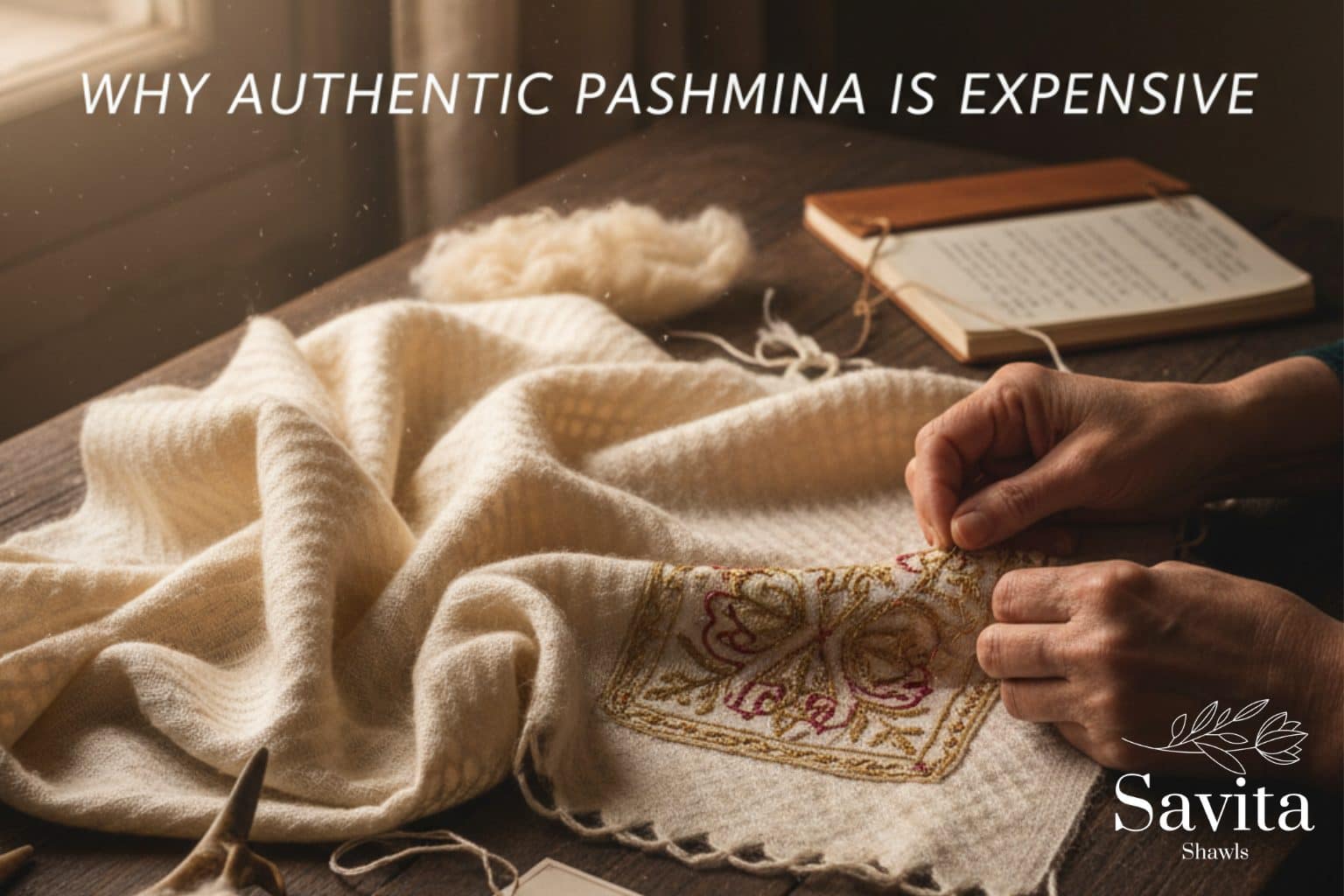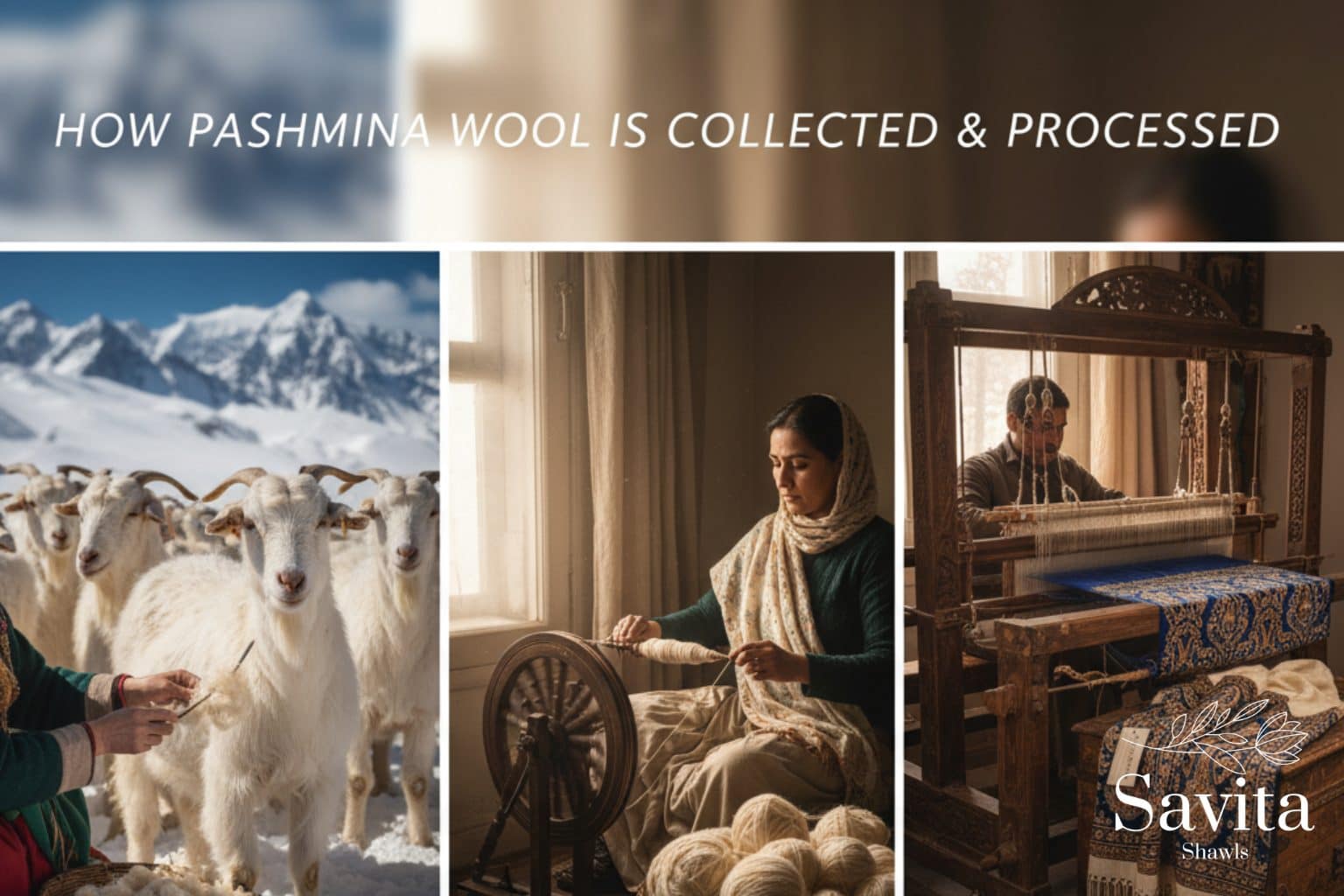Introduction: The Story Behind “Soft Gold”
For a long time, the Himalayas’ Soft Gold has been adored for its beauty, warmth, and elegance as no other. The Pashmina Shawl, one of the finest natural fibres ever discovered, is a luxury item that has gained worldwide recognition. The high-altitude regions of Ladakh and the Himalayas produce this tender wool, which not only offers comfort but also tells the tale of purity, craftsmanship, and heritage that never goes out of style.
The Birth of Himalayan Pashmina
The Soft Gold of Himalayas’ origin goes back to the tranquil Himalayan plateaus where the rare Changthangi goats endure the harsh cold. These hardy creatures develop an extremely fine undercoat, which is the base for the real Himalayan Pashmina. This fibre is carefully combed, not sheared, and then spun into Pashmina Wool for which the world has come to know for its lightness and good insulating power.
This transition from mountain to masterpiece adds to the value of Pashmina Wool. Each thread signifies the Himalayas in their most beautiful form — purity, patience, and perfection — and so it is turned into art which has attracted royals, designers, and collectors for centuries.
Why It’s Called the “Soft Gold of the Himalayas”
The term Soft Gold of the Himalayas sums up in a very poetic way the Pashmina’s allure as well as its cultural implications. Like real gold, the true Pashmina Wool is unique, lovely, and its value rises with time. It is very limited in production, entirely handmade, and deeply rooted in years of skilled craftsmanship. Each shawl requires the combined efforts of several artisans for weeks — often months — working in sequence — sometimes even across different regions — to spin, weave, and finish using the same traditional methods as their predecessors.
The value of Pashmina, beyond its price tag, lies in the emotional aspect. A Pashmina from the Himalayas is like having a history book or an access to the Himalayas, where the nature and the art of making the product have been merged perfectly, which the customers experience through softness that is not only physical but the tale of mountains, traditions, and human devotion intertwined.
The Legacy Lives On
The soft gold of the Himalayas still continues to hypnotize admirers in different parts of the world. The modern customers who are getting back to nature and handmade artistry are Pashmina wool standing out among the luxury products — very much high quality, environment-friendly, and timeless. At Savita Shawls, we respect this tradition by selling the purest Himalayan Pashmina that does not only have the original spirit and the worth of Pashmina — pure, classy, and forever.
Each shawl we make carries the sound of the wind blowing through the Himalayas and the artisan’s love. That’s why the soft gold of the Himalayas is more than just a word — it is a label of pride, skill, and cultural identity that has been resisting the passage of time for centuries and still is.
The Precious Source: Changthangi Goats
The Soft Gold of the Himalayas story is set right up in the peaceful and snow-clad heights of the mountains of Ladakh and Tibet, where, amidst the extremely inhospitable terrains, the rare Changthangi goats — better known as the Pashmina goats — manage to survive. These resilient mountain animals are the ones that produce Pashmina Wool the world’s most luxurious and highly prized textile fiber.
Birthplace of the Finest Fibre
Changthangi goats live at the highest heights — over 14,000 feet — and they have got used to the icy Himalayan winds which can be as cold as –40°C. To be able to cope with such cold weather, the goats get a nature-given very fine and warm undercoat — this is the delicate layer of Himalayan Pashmina fibre. It is the Huamalian Pashmina that takes the leading position in the Soft Gold of the Himalayas, which is so famous for its unparalleled softness, lightness, and natural warmth.
The collection of this most valuable fibre is a process imbued with care and tradition. In spring, when the goats start to lose their winter coats, local herdsmen comb the wool off the goats very gently by hand — they never shear or injure the animals. This moral way of doing things not only ensures that the goats are well treated but also that the fibre is pure, thus retaining the true value of Pashmina.
The Art of Collecting Pashmina Wool
The process of collecting Pashmina Wool is one that requires time, love, and a deep understanding of nature. A single Changthangi goat only yields about 80–150 grams of usable wool every year, which makes Himalayan Pashmina one of the rarest and most exclusive fibres in the world. The fineness of the fibre is usually between 12–16 microns, which is a number that indicates it is several times thinner than human hair — this is one of the major reasons why Pashmina is silky and has no rival in the world when it comes to texture.
What distinguishes the Soft Gold of the Himalayas from other kinds of cashmere and wool is the fact that it comes from a natural source. The goats’ habitat — the fresh air, the soil rich in minerals, and the vegetation — are all crucial factors in producing the soft and strong wool. There are no heat, chemicals, or synthetic fibers that can ever match the warmth, breathability, and sheath that Pashmina Wool has.
Nature’s Gift of Luxury and Value
One of the things that make Pashmina valuable is its price. It is a product of a wonderful relationship between nature and artisanship, where each filament partakes in narrating the saga of struggle, charm, and loyalty. The process from when the Changthangi goats lose their fleece to when it is turned into fine shawls by spinning and weaving is a journey of Himalayan Pashmina that shows centuries of respect for tradition and nature’s generosity.
This magnificent wool is frequently referred to as the “diamond fibre” of the Himalayas — rare, light, and elegant. The Soft Gold of the Himalayas still represents luxury and cultural glory, and it is a constant reminder that true beauty is always a result of being in harmony with nature.
Why Changthangi Goats Define Authenticity
If there are no Changthangi goats, then there will be no real Pashmina Wool, no genuine Himalayan Pashmina, and no true Soft Gold of the Himalayas. The combination of their special habitat and genes creates a fibre which is so Soft and Fine that it have been adored by emperors, queens, and collectors for hundreds of years. This natural exclusivity is one of the reasons Pashmina has such a long-lasting value—the value that is measured not only in rarity but also in the heritage and purity of the product.
The relationship among these goats, the mountain pasture, and the Kashmir artisans is what keeps the Soft Gold of the Himalayas vibrant in our times—a tradition that is getting even more alive with every generation that passes down the skill to portray it.
The Labour-Intensive Craftsmanship Behind the Soft Gold of the Himalayas
What really distinguishes Pashmina as the Soft Gold of the Himalayas is not only its rarest wool but also the exceptional artistry that elevates this fragile fiber into the most valuable heirloom. The production of Himalayan Pashmina is a matrix of love, creativity, and deep-rooted ethnic customs — it has undergone more than 30 elaborate stages, all performed manually by the master weavers of Kashmir and Himachal Pradesh.
Every single Pashmina Wool strand carries along with it the skill, patience, and feelings of the past. The changing of raw fiber to a luxuriously soft wrap is a slow, meditative process that shows the spirit of the mountains and the loyalty of craftsman generations.
Step-by-Step Artistry That Defines the Soft Gold of the Himalayas
- Fibre Sorting and Cleaning:
The journey kicks off with the sorting of the raw Pashmina Wool collected from the Changthangi goats. The artisans sort the wool with great care. Each fiber is then gently cleaned to get rid of impurities, while its natural softness and texture are still preserved. The purity of the fabric is what differentiates Himalayan Pashmina from other fabrics processed by machines. - Hand Spinning:
With the help of a traditional wooden tool known as Charkha, the wool is cleaned and then spun into very fine threads. This is one of the most delicate and time-consuming steps, as the fineness of Pashmina Wool demands exceptional skill and steady hands. A single mistake can break the thread, making this task a true test of craftsmanship. - Hand Weaving on Wooden Looms:
The spun threads are then woven into fabric using ancient wooden looms — a tradition that has been passed down for centuries. This process can take several weeks, depending on the pattern and texture. The rhythmic motion of the loom is not just weaving threads but weaving stories of the Soft Gold of the Himalayas. - Dyeing and Finishing:
The first step is the weaving of the spun threads into fabric using the same old wooden looms — a process that has been carried down through generations. Such a task may require weeks or even longer, depending on the selected pattern and texture. The steady rhythm of the loom is not just interlacing the threads but also narrating the tales of the Soft Gold of the Himalayas. - Embellishment and Embroidery:
Among the various usages, the most common one for the Pashmina Shawls is covered by the delightful and momentous Kashmiri embroidery, which is Sozni or Tilla work, through which one can wait for months to see the final result. This incredible workmanship not only amplifies the worth of Pashmina but also converts every shawl into a piece of art that is adored by the world’s collectors and is hence, always ready to keep being re-treasured.
Why the Craftsmanship Adds to the Value of Pashmina
The labor-intensive procedure of creating Himalayan Pashmina manually is a prominent explanation for its being compared to the Soft Gold of the Himalayas. Animal matted wool fibers, which are the basis for one design, are then sorted according to their color and length by an artisan, who usually takes weeks to finish one. The whole process is so intimate and skillful that it results in completely different and unique pieces—the story and warmth of the maker are in each one.
This attachment of human factor keeps the price of Pashmina increasing in the world market. The consumers of today are not just attracted by its luxurious touch and heat but also by the moral, eco-friendly, and handmade route that each shawl has traveled through.
When you possess an authentic Pashmina Wool Shawl, it’s as good as possessing a part of Asia’s Himalayan Heritage—a sign of sophistication, tolerance, and skill that is never going to be out of fashion.
The Unmatched Softness and Warmth of the Soft Gold of the Himalayas
The truly legendary status of Pashmina Wool — commonly referred to as the Soft Gold of the Himalayas — is attributed to its astounding softness, warmth, and silky texture. No other natural fibre on the planet is able to boast such an amazing combination of being ultra-light and yet having a great insulating property at the same time. Every single strand of Himalayan Pashmina is a wonder of nature—the harshness of the mountain is the miracle to some extent—and man is the one who then perfects it through skilled craft.
Pashmina Wool is distinct, chiefly because of its fineness grade. The fibre accounts for the size of only 12–16 microns in diameter; hence, the Himalayan Pashmina is about 8–10 times thinner and smoother than regular sheep’s wool or artificial substitutes. When you get to feel the authentic Pashmina Shawl, it gives the impression of coming into contact with a cloud—feel-free, velvet-like, and calming on the skin. Hence, mankind regards it as the real Soft Gold of the Himalayas.
The Science Behind Its Warmth and Lightness
The power of insulation in Pashmina Wool comes from its natural crimped structure. These microscopic woven patterns inside the fibres do not only trap body heat, but they also make the temperature very mild even in freezing outdoor conditions—without appearing bulky. In other words, wherever you are, i.e. whether you are enduring the icy winds of Ladakh or enjoying the cold of a winter evening in Delhi, the Himalayan Pashmina will keep you warm but at the same time your skin will not perspire due to the breathability of the fabric.
The combination of warmth and lightness creates the true Value of Pashmina. Artificial fibers may be able to copy some of its properties, but none can imitate the natural thermal balance and permeation that are behind the uniqueness of the Soft Gold of the Himalayas.
The Touch of Luxury and Elegance
Pashmina Wool, apart from its practical use, is a luxury that touches our feelings deeply. The skin is treated to a super soft touch, and the light weight of the fabric is such that every clothing is enhanced by it. The glow of the fabric is natural and it shows elegance. No matter how it is worn, be it as a shawl, a stole, or a scarf, Pashmina from Himalaya hills is the very picture of grace and snug that beat even the fads and ages.
Pashmina princes and royalty did not merely wear a piece of cloth but they did wrap themselves with the art of the Himalayas that lasted for centuries. Toppers and aficionades still count original Pashmina Wool Shawls among the items of cultural heritage and luxury. By having one, you are in possession of the Soft Gold of the Himalayas, a unique asset that increases in value over time.
Why the Value of Pashmina Endures
The rarity of Pashmina is just one reason for its enduring value; the other is the painstaking care taken at each step of production. The Changthangi goat is the source of the fibre, and the Kashmiri craftsmen who weave it by hand are examples of patience and meticulousness and love in every stage. This credibility gives Himalayan Pashmina an emotional and financial value that is comparable to few other textiles.
On top of that, Pashmina is a wool that is a biodegradable fibre and eco-friendly — making it a luxurious but at the same time environmentally friendly choice. As the world gradually moves to the slow fashion trend, the Soft Gold of the Himalayas still shines bright as the epitome of conscious luxury and elegance that never goes out of style.
Rarity and Global Demand for the Soft Gold of the Himalayas
The Soft Gold of the Himalayas is famous mainly for its great rarity and therefore high value. In contrast to fibers that are produced in huge quantities, Pashmina Wool has a very small source from which it is obtained — the Changthangi goats that inhabit the frigid alpine places of Ladakh and Tibet. The production of each goat is only 70-100 grams of fine Himalayan Pashmina per year, and even fewer of them are up to standard of purity that can be called a real Pashmina Shawl. This situation gives the Soft Gold of the Himalayas the quality of being one of the rarest and most valuable natural fabrics ever to exist.
The process of production of raw Pashmina Wol into luxurious shawls takes time and is laborious. The skilled Kashmiri artists hand-spinning, weaving, and finishing each piece — making sure that every shawl is a masterpiece of patience and craftsmanship. Due to the fact that production is all manual and seasonal, supply still remains small even when global demand is increasing. The whole situation of the demand being just right and the supply being limited adds to the value of Pashmina making it an item that will always be desirable and so exclusive.
Rising Global Appreciation for Himalayan Pashmina
The world is more and more appreciating the Himalayan Pashmina. Eco-conscious customers and luxury connoisseurs have all found the authenticity and sustainability of the Himalayan Pashmina to be intoxicating in the world of fast fashion and synthetic fabrics. Modern-day designers in Paris, Milan, and London already use the Soft Gold of the Himalayas as a major source of inspiration for their collections highlighting its natural warmth, elegance, and cultural legacy. The customers themselves don’t consider owning a genuine Pashmina Wool Shawl among the luxuries — they think it is about having a cultural inheritance and sustaining the art of craftsmanship.
The continuous acknowledgement of Pashmina has been one of the main reasons for its global value increase. The Pashmina demand has come from the royal families, celebrities, and collectors, who all want to get a piece of the ancient and a connection with this luxurious mountain treasure. Each original Pashmina that comes from the Himalayas has in it the skills, the quality, and the beauty that can never be achieved by any artificial fabric.
Why the Value of Pashmina Continues to Rise
Pashmina Wool’s increasing global demand has also caused the great efforts to protect the wool and carry its authenticity to the next level. Government organizations, cooperatives, and sustainable brands like Savita Shawls are working together to set up certification policies like GI tagging, whereby every product that claims to be Pashmina from the Himalayas is guaranteed to be handwoven and produced ethically. The faster the market accepts the concept of luxury that is sustainable, the faster the Soft Gold of the Himalayas gains more prestige.
A real Pashmina Shawl is now regarded as a status symbol — not just in the realm of fashion but also in that of art, culture, and sustainability. Its value increases over the years, and the tale it tells is passed down from one generation to the next, thus promoting Pashmina’s global appeal and sharing part of it with the world from the Himalayan plateau.
Economic and Cultural Importance of the Soft Gold of the Himalayas
The Soft Gold of the Himalayas is not only a luxury symbol but also the main source of life for the communities in Himalayas. The whole ecosystem of Pashmina Wool supports thousands of people living in Ladakh, Kashmir, and Himachal Pradesh. The hard to high-altitude herdsmen, who care for the Changthangi goats, and the master artisans who hand-spin and weave each shawl, are the ones participating in the Pashmina chain that goes through mountain economies and sustains them.
This global natural fibre, which is even referred to as the Soft Gold of the Himalayas, still supports the economy of the less developed areas where only the Pashmina industry seems to be the only exception for thriving. The tough environment and remoteness make it hard for farming but at the same time the Pashmina wool production brings to the valley the so-called sustainable income and empowerment — women, in particular, are the ones who usually get involved in spinning and hand-finishing. The Value of Pashmina is not only a monetary issue for many families but also a matter of pride, heritage, and identity.
Livelihoods Woven with Tradition
The Himalayan Pashmina industry is a link between the past and present. Each shawl tells the story of those artisans who have kept the same weaving techniques for centuries. Each and every strand of Pashmina Wool represents patience, precision, and the creative spirit of the Kashmiris. The Soft Gold of the Himalayas is not just a job, but rather a love affair that connects culture, family, and history.
The Value of Pashmina is mainly in its fluffy texture. It is a symbol of the artist’s dignity, the woman’s independence, and the master’s respect for the ancient craftsmanship. This cultural heritage is still strong in the community and helps to keep the old Pashmina spirit alive for the next generation.
Government Support and Global Recognition
In order to prevent the extinction of this rare and precious practice, the government of India and the allied institutions have taken up to the challenge and launched a number of schemes to keep the Pashmina Wool real. One of the most major actions taken was the issuance of Geographical Indication (GI) tags, which confer upon the Himalayan Pashmina the status of a unique product of that particular region. This consequently also means that only the true and painstakingly hand-woven items from Kashmir and Ladakh are sold under the title “Pashmina,” thereby safeguarding the artisans from the risks of unfair competition and the selling of counterfeit products along with them.
This kind of recognition increases the Price of Pashmina in the world’s markets and leads to the thoroughness in the dealings of the luxury textile industry. The likes of Savita Shawls, to the extent of their influence, are also involved in creating such a scenario — participating in the campaign meant for rural weavers’ support, practicing the ethical ways of sourcing, and telling people about the cultural and economic importance of the Soft Gold of the Himalayas.
The meeting of the age-old artisanal workmanship and the modern-day advocacy translates to the Indian Pashmina being around not only as a luxury but as an emblem of sustainability, authenticity, and cultural pride.
Savita Shawls: Upholding the Gold Standard of Himalayan Elegance
Savita Shawls is proud to be the guardian of the Soft Gold of the Himalayas — a legacy that reflects the Best of nature, culture, and skill. For us, Pashmina Wool is not just a material; it’s a narrative of dedication, creativity, and the vibrant nature of the Himalayan craftsmen. Being the foremost shawls manufacturers in Delhi, India, we have made it our mission to keep the true nature of Himalayan Pashmina with us, and by that, we mean every creation we make is a sign of luxury, purity, and authenticity.
Crafting Excellence with Authentic Himalayan Pashmina
At Savita Shawls, when each shawl gets its start in the cold, immaculate mountains of Ladakh where the rare Changthangi goats produce the thin pelt known as Pashmina Wool. The transformation of this precious resource – which is the Silk of the Himalayas – into beautiful shawls, stoles, and wraps that exude elegance, is done by skillful Kashmiri artisans.
Our workers do hand spinning and weaving using traditional methods that have been passed down from their forefathers, thereby guaranteeing that every piece of Himalayan Pashmina has the original softness, warmth, and elegance. The art could be as simple as a plain shawl or as elaborate as a richly embroidered beauty; still, the worth of Pashmina—the perfect balance of nature’s gift and human creativity—is always manifested in it.
Diverse Collections Reflecting Royal Heritage
At Savita Shawls, we present a diverse variety of collections that not only capture the magnificence but also the cultural richness of the Himalayas’ Soft Gold. Our offerings of Pashmina Shawls, Kani Shawls, Jamawar, and Cashmere are intended to meet the demands of modern tastes without disregarding the ancient craftsmanship involved.
The collection highlights the very Himalayan Pashmina with its remarkable softness, featherweight, and long-lasting nature. Every design is carefully chosen to show not only the present trend but also the royal sophistication that was once typical of kings and queens. The merging of modernity and tradition guarantees that each item is a continuous flow of the rich legacy and superior Quality of Pashmina.
Ethical Craftsmanship and Artisan Empowerment
Savita Shawls stands out mainly because of its strong commitment to the ethical sourcing and fair-trade practices. The workers involve artisan families from Kashmir and Ladakh directly so that they receive adequate pay and acknowledgment for their artistry. This practice not just keeps the ancient among the Pashmina Wool weaving butalso helps the rural communities who have been taking care of the Soft Gold of the Himalayas for centuries to rise up economically.
By incorporating eco-friendly and open production practices, we keep the extinction of Himalayan Pashmina. Every shawl you buy supports the preservation of a craft and also the idea of responsible luxury, which is a key element of Pashmina’s true Value.
Our Promise: Tradition, Quality, and Global Standards
Every creation of Savita Shawls passes through quality checks that are very strict and these are required for Indian and international standards of excellence. We want not only to sell a beautiful product but also to keep the Soft Gold of the Himalayas clean. Our Pashmina Wool shawls will be a source of warmth, elegance, and an unbroken link to the Himalayan heritage whether you are buying them for a gift or for your personal collection.
To us, a single thread of Himalayan Pashmina is a story of trust, tradition, and transformation interwoven—age-old one that brings the Value of Pashmina from the mountains to the world’s homes.
Conclusion: The True Worth of Pashmina — The Eternal Soft Gold of the Himalayas
The Soft Gold of the Himalayas is more than a luxury fabric; it is a historical milestone showing human creativity, cultural pride, and natural beauty among the most prominent of mankind’s achievements. Pashmina Wool has been at the forefront of the luxury market presenting elegance, heat, and subtlety—being the most prized possession of kings, queens, and collectors all over the world. Every single thread of Himalayan Pashmina holds the tale of the mountains, the love of the skilled artisans, and the forever connection of nature and craftsmanship.
The Pashmina’s worth is much more than what the tag indicates. It is a struggle of generations who have been keeping this elusive heritage alive who have thus immortalized the Pashmina not only the mountains but also the looms. The whole process of Pashmina Wool from the icy tops of Ladakh to Kashmir’s looms symbolizes the earth and man’s cooperation, the simplicity and the sophistication. When someone has on a genuine Pashmina Shawl, that individual has history, care, and culture for centuries—he/she has the Soft Gold of the Himalayas itself.
The Legacy of Warmth and Craftsmanship
Himalayan Pashmina’s remarkable softness and warmth are universally considered the best in the entire textile industry. The production of a single authentic shawl takes months of hard work — from hand-combing the Changthangi goats to the delicate weaving by Kashmiri artisans as well. Each item indicates the virtues of patience, precision, and a deep affection for the classic. The commitment to quality and detail that has been timeless guarantees that the Soft Gold of the Himalayas continues to be a symbol of perfection and pride.
Pashmina Wool heritage signifies the Himalayan character — untainted, tough, and elegant. It bridges the ancient and the modern in the artistic field and, by offering a piece of history, it has still, through the ages, been the source of the new generations’ inspiration.
A Timeless Treasure for Generations to Come
Buyinig a Himalayan Pashmina is not just a luxurious shawl but a cultural legacypiece. The Value of Pashmina is in its timelessness and emotional depth—this is why it is passed down as a family heirloom and why it is cherished for the story it tells as much as its softness. True Pashmina Wool thus stands as a reminder of nature’s gifts and the beauty of slow, mindful craftsmanship as sustainable luxury keeps on grabbing the world’s attention.
At Savita Shawls, the Soft Gold of the Himalayas is to be honored and celebrated, not just worn. Each shawl that we produce is the homage to the craftspeople, who, with their skills, are enabling the Pashmina of the Himalayas to live on as a dream.
Savita Shawls: Continuing the Golden Legacy
For us, the Soft Gold of the Himalayas is more than just an inspiration — it is our very own signature. With the help of our hand-made collections, we make sure that the true essence of Pashmina Wool is never covered up by imitation or mass production. Our objective is to conserve the genuineness of Himalayan Pashmina, to respect its cultural roots, and at the same time, to introduce it to the modern world with class and integrity.
When you go for Savita Shawls, you are not merely getting a piece of clothing — you are backing a very old art form, empowering the local labor force, and accepting the Value of Pashmina in its very purest, and most significant, form.
The Soft Gold of the Himalayas will keep on being the emblem of purity, heritage, and luxury that is never out of date — a masterpiece that is forever brilliant through ages.
Related Products
Showing 1–6 of 805 results
-
Savita Shawls Royal Blue & Black Wool Natural Silk Box Pashmina Shawl for Women
Read more -
Savita Shawls Elegant Grey & Black Wool Natural Silk Box Pashmina Shawl for Women
Read more -
Beige & Charcoal Wool Natural Silk Box Design Pashmina Shawl for Women
Read more -
Yellow & Navy Wool Natural Silk Box Design Pashmina Shawl for Women
Read more -
Grey & Black Wool Natural Silk Box Design Pashmina Shawl for Women
Read more -
Red & Beige Wool Natural Silk Box Design Pashmina Shawl for Women
Read more


